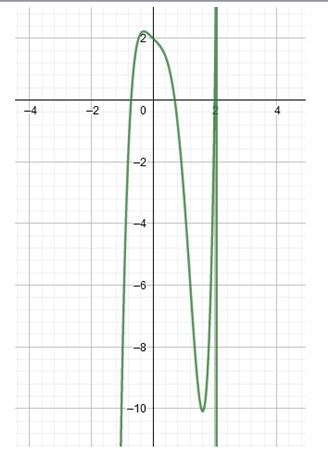
In Problems 91-98, analyze each polynomial function using Steps 1 through 8 on page 193 in Section 4.1.
[Hint: See Problem 67.]
To analyze: The polynomial function .
Answer to Problem 83AYU
.
Explanation of Solution
Given:
Step 1: Determine the end behavior of the function
The polynomial function is of degree 5. The graph of behaves like for large values of .
Step 2: Finding the and of the graph of the function
To find the , finding
To find the , solving
Using synthetic division
Step 3: Determining the zeros of the function and their multiplicity to find the graph crosses or touches the at each intercept.
The zeros 2, and each have multiplicity 1. Therefore at 2, , the graph crosses the
Step 4: Using the graphing utility to graph the function.

Step 5: Approximate the turning point of the graph
From the graph of , we see has 3 turning points
Using the graph maximum turning point rounded to two decimal places
Using the graph minimum turning point rounded to two decimal places
Step 6: Redraw the graph
The graph passes through and
The end behavior of the graph
Step 7: Find the domain and range of the function
The domain and range is the set of all real numbers
Step 8: Use the graph to determine where the function is increasing or where it is decreasing
Based on the graph, is increasing on the intervals and
Based on the graph, is decreasing
Chapter 4 Solutions
Precalculus Enhanced with Graphing Utilities
Additional Math Textbook Solutions
A First Course in Probability (10th Edition)
Elementary Statistics (13th Edition)
A Problem Solving Approach To Mathematics For Elementary School Teachers (13th Edition)
Thinking Mathematically (6th Edition)
Introductory Statistics
University Calculus: Early Transcendentals (4th Edition)
- A ladder 27 feet long leans against a wall and the foot of the ladder is sliding away at a constant rate of 3 feet/sec. Meanwhile, a firefighter is climbing up the ladder at a rate of 2 feet/sec. When the firefighter has climbed up 6 feet of the ladder, the ladder makes an angle of л/3 with the ground. Answer the two related rates questions below. (Hint: Use two carefully labeled similar right triangles.) (a) If h is the height of the firefighter above the ground, at the instant the angle of the ladder with the ground is л/3, find dh/dt= feet/sec. (b) If w is the horizontal distance from the firefighter to the wall, at the instant the angle of the ladder with the ground is л/3, find dw/dt= feet/sec.arrow_forwardTwo cars start moving from the same point. One travels south at 60 mi/h and the other travels west at 25 mi/h. At what rate (in mi/h) is the distance between the cars increasing four hours later? Step 1 Using the diagram of a right triangle given below, the relation between x, y, and z is z² = x²+ +12 x Step 2 We must find dz/dt. Differentiating both sides and simplifying gives us the following. 2z dz dt dx 2x. +2y dt dx dy dz x +y dt dt dt 2z dy dt × dx (x+y dt dy dtarrow_forwardAn elastic rope is attached to the ground at the positions shown in the picture. The rope is being pulled up along the dotted line. Assume the units are meters. 9 ground level Assume that x is increasing at a rate of 3 meters/sec. (a) Write as a function of x: 0= (b) When x=10, the angle is changing at a rate of rad/sec. (c) Let L be the the left hand piece of rope and R the right hand piece of rope. When x=10, is the rate of change of L larger than the rate of change of R? ○ Yes ○ Noarrow_forward
- 4.1 Basic Rules of Differentiation. 1. Find the derivative of each function. Write answers with positive exponents. Label your derivatives with appropriate derivative notation. a) y=8x-5x3 4 X b) y=-50 √x+11x -5 c) p(x)=-10x²+6x3³arrow_forwardPlease refer belowarrow_forwardFor the following function f and real number a, a. find the slope of the tangent line mtan = f' (a), and b. find the equation of the tangent line to f at x = a. f(x)= 2 = a = 2 x2 a. Slope: b. Equation of tangent line: yarrow_forward
 Calculus: Early TranscendentalsCalculusISBN:9781285741550Author:James StewartPublisher:Cengage Learning
Calculus: Early TranscendentalsCalculusISBN:9781285741550Author:James StewartPublisher:Cengage Learning Thomas' Calculus (14th Edition)CalculusISBN:9780134438986Author:Joel R. Hass, Christopher E. Heil, Maurice D. WeirPublisher:PEARSON
Thomas' Calculus (14th Edition)CalculusISBN:9780134438986Author:Joel R. Hass, Christopher E. Heil, Maurice D. WeirPublisher:PEARSON Calculus: Early Transcendentals (3rd Edition)CalculusISBN:9780134763644Author:William L. Briggs, Lyle Cochran, Bernard Gillett, Eric SchulzPublisher:PEARSON
Calculus: Early Transcendentals (3rd Edition)CalculusISBN:9780134763644Author:William L. Briggs, Lyle Cochran, Bernard Gillett, Eric SchulzPublisher:PEARSON Calculus: Early TranscendentalsCalculusISBN:9781319050740Author:Jon Rogawski, Colin Adams, Robert FranzosaPublisher:W. H. Freeman
Calculus: Early TranscendentalsCalculusISBN:9781319050740Author:Jon Rogawski, Colin Adams, Robert FranzosaPublisher:W. H. Freeman
 Calculus: Early Transcendental FunctionsCalculusISBN:9781337552516Author:Ron Larson, Bruce H. EdwardsPublisher:Cengage Learning
Calculus: Early Transcendental FunctionsCalculusISBN:9781337552516Author:Ron Larson, Bruce H. EdwardsPublisher:Cengage Learning





